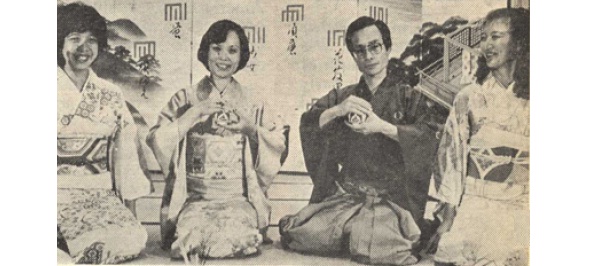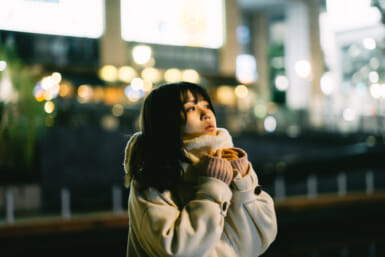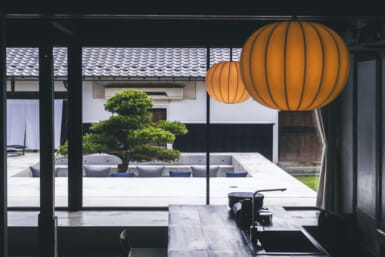Scent Games
Now for something really exotic. If you have come to Japan hoping lo take away with you an experience of a different category, something without the dull ring of a Japan cliche, something steeped in an ancient tradition, something with a bit of a cachet — well, this is it.
Kohdo, the ritual appreciation of incense, is a rarefied aesthetic cult. Kohdo (koh means “incense” and do means “way of knowledge”) first appears in Japanese literature in the 11th century, but is pretty clearly even older than that. Sado, the tea ceremony, derives much of its ritual from kohdo. As kohdo is now actively practiced by only a few hundred people in all of Japan, it is an exceedingly esoteric pastime, but at the same time a very accessible one: everyone has a sense of smell.
Those schooled in kohdo have taken the sense of smell, which we all take more or less for granted, and raised it to a scarcely credible level of discrimination. An experienced practitioner of kohdo can identify and put a name to several hundred scents. There are altogether about six hundred scents in the koh pantheon, but many of these are so rare (and so expensive—top-class koh is ounce-for-ounce more expensive than gold) that they might as well no longer exist.
On the last Friday of each month, the Gyounkai Incense Appreciation Society meets twice, once at one o’clock and once at six-thirty. Fifteen to 20 people usually attend the sessions, which are held in a reserved room on the 34th floor of the Kasumigaseki Building in Toranomon, not so long ago the highest building in Japan, across the hall from the premises of the Peers’ Club. Mr. Gyoun Sanjounishi, a very kind and almost supernaturally modest man who happens to be nephew of the Empress of Japan, is the Society’s teacher.
Sanjounishi-sensei’s meishi identifies him as the 22nd-generation teacher of this school of kohdo, which is the school founded by aristocrats and the Imperial Family, as opposed to the other major school, which was founded by samurai. (The difference between the two schools seems to be largely how one holds one’s arms as one partakes of the incense—modestly to the side of the body or in a more aggressive stance.)
It is a curious sensation to take part in this venerable ceremony while seated on chairs constructed of chromium tubing in a room illuminated by fluorescent lights, with the metropolis of Tokyo spread out below, a view the ancient kohdo masters couldn’t possibly have imagined.
Several days before the session, you should call (in Japanese, of course) either Sanjounishi-sensei at (0467) 83-5406, or one of his assistants, Ms. Enda at (044) 988-3142 or Ms. Miyoshi at (03) 323-7712, to tell them of your interest in kohdo and to ask them to let you attend a session. Although kohdo is hardly a proselytizing discipline, essentially because good koh is so scarce, you are sure to be welcomed. Only remember to wear no perfume or flowers and not to have recently drunk coffee or eaten garlic, and not to wear rings or a necklace, because they might accidentally strike against the cup bearing the incense, causing a small distraction.
Check your coat at the cloakroom on the 34th floor and enter the room where the session will be held. Ms. Enda or Ms. Miyoshi will take you in hand. On a long table you will find a number of envelopes, and there may be one with your name on it. If there is, slip ¥5,000 into it (rarefied experiences tend to be expensive!) and take one of the sheets of paper which sets out the form the session’s exercise will take.
As this will comprise a passage of classical Japanese literature written in the flowing hand of Sanjounishi-sensei‘s wife and what appears to be an alchemic formula, it will probably make little sense. Don’t worry: no one will expect you to understand and you will be given a seat near someone who will lead you through the ritual Proceed by dutiful imitation, just as you would follow the proceedings at an unfamiliar religious service by watching your neighbor out of the corner of your eye.
Everyone in the Gyounkai has known each other for years so the talk around the table before the session starts is the relaxed chatter of friends. In the corner of the room several of the more experienced people will be heating the small charcoal cylinders called tadon which when glowing will be buried in cups of ashes of the seeds of the pond lily, so chosen for their odorlessness, color and fineness when reduced to ashes.
After the tadon is buried in the ashes in a cup (which itself can be an object of veneration, as in the lea ceremony), an intricate pattern is made in the surface of the ashes to reflect not only the season but also give a hint of the form of the contest to come.
Meanwhile at the head of the table, the Koh Master for the session readies her equipment. There are seven tools— a small set of pincers called gingyobasami, a poker, a set of chopsticks, two spade-like implements, and a feather from the wing of a crested ibis (to brush away any stray ash from the side of the cup.)
A small tray with folded strips of Japanese paper is passed around the table. Bow to your neighbor, take one of the slips of paper, write your name on it, and set it in front of your place. Later you will write your answers on it. The session’s Record Keeper, who Koh Master, is busy inscribing by brush the names of the attendants on a large sheet of Japanese paper on which everyone’s answers will eventually be recorded, right or wrong, for everyone to see.
The Koh Master announces, “Koh hajimemasu” (“The koh ceremony will begin”) and proceeds in a manner which recalls the tea ceremony to fold a napkin, wipe the gingyobasami and lay her implements gracefully down on the pad of paper before her, making the absolute minimum of noise. In the room now, dead silence. For the next 40 minutes or so only the Koh Master will speak, and then only sparingly, as dictated by the ritual.
The Koh Master opens a box containing ten small squares of quartz, which she arranges on a wooden holder. Using her gingyobasami, she then carefully places one of the quartz squares on top of the pattern of ashes in a cup, over the burning charcoal.
She then unwraps the first piece of koh, a piece of wood naturally saturated with fragrant oils, a gift of nature only as large as the paring of a fingernail—and places it on top of the quartz, which is beginning to heat up. After a few moments, the Koh Master lifts the cup to her nose and, cupping her left hand over the cup to focus the scent, “listens to” the fragrance. (In the vocabulary of kohdo, the verb “to smell” is kiku, which in every-day Japanese means “to listen to.”) If the Koh Master judges the koh to be giving off scent properly, she will pass the cup to the person on her right, announcing, “Kokoromi ichi de gozaimasu” (“This is the first test scent.”)
The most common form the koh contest takes is for the Koh Master first lo pass around the table one or more “test” scents, after which three or more “real” scents (hon koh) are passed around. The participants must then identify these real scents as being the same as a particular test scent or as being a ringer, not one of the test scents at all. The contest can be fieldish, as all the hon koh to be identified might be the same koh or, equally deceptive, all might be ringers.
There are formally more than 2,000 forms a koh contest can take, some of wondrous complexity with the answer required to be given in the form of a haiku composed on the spot. Mind games soon become part of the matching of scents, as the mind naturally tries to discriminate between very subtle differences, searching for a connection between some deliciously fragrant koh from the outside ring of a tree and a koh from nearer the core of the same tree. Are they the same koh or are they different?
Charcoal heated to different degrees can also suggest illusory differences between two bits of the same koh and even the fragrance of the same piece of koh will come in waves, its intensity waxing and waning as the cup in which it nests is passed around the table.
After the test koh have been passed around the table, the Koh Master will say, “Hon koh hajimemasu” (“Now begins the real koh, the koh which have to be identified.”) She puts her hand over a cup to check that the heat is sufficient, then opens a packet of paper to extract a sliver of koh — she doesn’t know herself which koh it is — and carefully places it on the heated quartz square over the ashes. “Hon koh ichi de gozaimasu” she intones (“Real koh number one”) and passes the cup to the person on her right (just as in the tea ceremony), who lifts the cup with her right hand and turns it counterclockwise half a turn (just as in the tea ceremony), cups her left hand over the cup to focus the scent and inhales softly three times.
There are different styles in listening to koh. Some people take their time between inhalations, and close their eyes, a faint smile playing on their lips; some listen more matter of factly, nodding to themselves as if to say, “OK, message received.” The cup proceeds around the table, everyone listening to the koh in turn and perhaps afterwards making a discreet note so they can more easily formulate their response after all the cups of koh thave circulated.
By this time, the room is beginning to fill with mingled scents, which is delightfully confusing. (The classic kohdo setting is in a teahouse, where there is likely to be less of a problem of lingering scents. The members of Gyounkai wear kimono to meet several times a year in a teahouse, most notably the beautiful teahouse on the grounds of Meiji Shrine, together with the members of other kohdo associations—these monthly sessions in the Kasumigaseki Building are regarded only as practice sessions.)
As the last cup is passed back to the Koh Master, she announces, “Hon koh taki owarimashita” (“The koh fire is out”) and everyone transcribes their answers on the slip of Japanese paper they have previously written their name on. You may need some help at this point because each of the test scents to which you must match the real scents has been given a name like “Snow” or “Wind” or “Flower.” Then a tray is passed around to collect the answers. The Record Keeper writes everyone’s answers on her large sheet of paper and ruthlessly ticks off the correct answers with vermilion ink.
Gyounkai members are generally very experienced in kohdo and several people will probably correctly match all the real scents with the test scents. Only at this point will you come to understand that kohdo requires very considerable skill.
The record of everyone’s answers is passed around the table and Sanjounishi-sensei may offer a gentle comment on the session’s deceptive points. The large sheet of paper recording the answers is awarded to the person who has done best. There may be some unexpired koh left over, in which case lots are drawn for it, as people who appreciate koh like to enjoy it at home. Conversation turns to everyday matters and as you leave the Kasumigaseki Building you will smell the world outside with a heightened awareness.










